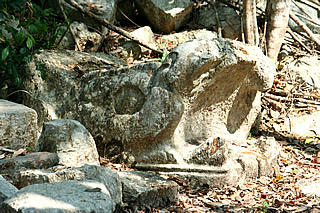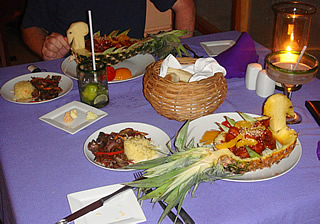

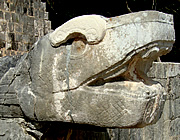
Rather lacking in atmosphere but with impressive buildings - especially the massive ball court - and beautiful carvings of serpents, jaguars and eagles.
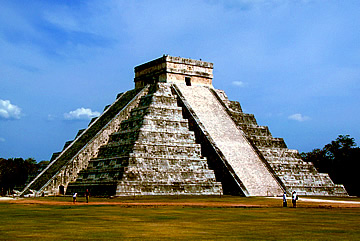
We left Merida around 7a.m. to get to Chichen Itza as soon as possible. Our packed breakfast didn't arrive - we were a bit early for the hotel breakfast and they said they'd get us juices and muffins - but they apologised and didn't charge for our drinks the previous evening so we weren't complaining!
We arrived around 8:30 when there were not many people around. After the many wonderful sites we had seen, Chichen Itza had a lot to do to impress. Though it does have some wonderful things to see we found it all a bit sanitised. The site can receive up to 15,000 visitors per day in the high season1 and it is understandable that it is no longer possible to climb the major structures. The excavated site covers some 5 sq km and it does have some beautiful stone carving.
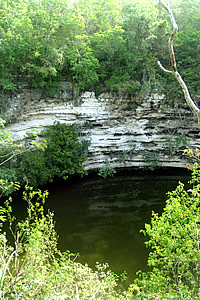
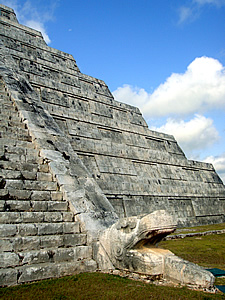
The name Chichen Itza means "At the edge of the well of the Itzaes"1 as it was built close to two cenotes - natural wells which allow access to underground water. The city seems to have enjoyed two periods of prosperity, the first grew between the fifth and tenth centuries and is now known as Chichen Viejo. The second grew after the invasion of the Toltecs from central Mexico in the tenth century and the city was either conquered by King of Tula, Ce Acatl Topiltzin Quetzalcoatl, translated as Kukulkan by the Maya or had strong links with the Toltecs.1,2 Quetzalcoatl, or Kukulcan, is the name of the plumed serpent god.
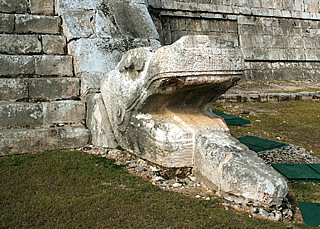
The city thrived and new buildings fused the ancient Mayan and incoming Toltec styles and Chichin Itza is the most important site of remaining of the Maya-Toltec civilisation. The Toltecs were a brutal race who ferociously subjugated the city and are thought to have introduced the practice of human sacrifice. The city was abandoned some time in the fifteenth century.
On entering the site the impressive 32m high Pyramid of Kukulcan, or El Castillo, can be seen set in a wide expanse of flattened ground, probably once a grand plaza. The four-sided steep step pyramid has a central staircase on each face and is stopped by the temple of the Jaguars. On the northern side the staircase is flanked by plumed serpent heads at ground level.
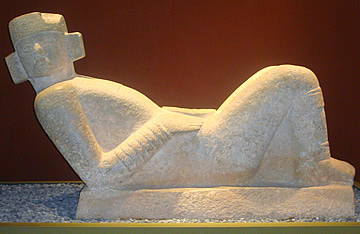
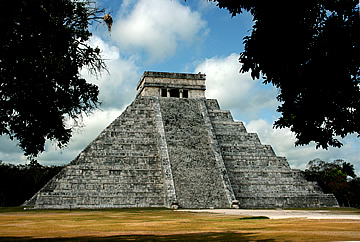
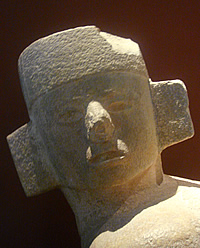
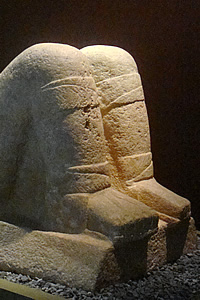
As with many Mayan monumental buildings this was built over an earlier one. Inside the earlier pyramid was found a red-painted jaguar throne embedded with pieces of jade and a Chak Mool, the emblematic reclining figure seen in a few buildings here. Chak Mool means "red claw" and may have been the local name for the red jaguar throne. The Chak Mool may have been an altar, perhaps where the heart was placed after human sacrifice, and thought of as a bridge between the Mayans and their gods.
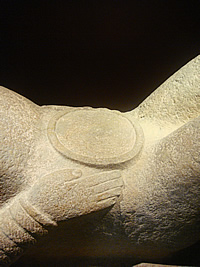
The pyramid obviously had strong astronomical and temporal associations for the builders. Each staircase has 91 steps and together with the step on the upper platform around the temple this totals 365 - the number of days in the year. Numerous other mathematical associations can be detected. The most spectacular effect of the building can be seen at the spring and autumn equinoxes, when the sun is directly over the equator. On these days, at sunset, the corners of the nine platforms cast a sinuous shadow on the side of the northern steps which end at the head of the snake. As the sun sinks the snake shadow appears to move down.
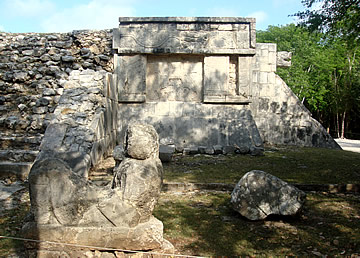
The Platform of Venus lies just to the north of the Pyramid of Kukulcan. Venus, or the Morning Star, was another very important feature in Mayan mythology, a symbol of rebirth and therefore also associated with the serpent which appears to be reborn when it sheds its skin.
The low, square platform has a staircase on each side. At the top of each of these are sculptures of plumed serpents' heads. The panels around the platform are decorated with carvings of the morning star, sinuous Kukulkan shapes, fishes, matting (a symbol of power), twisted rope and human heads emerging from between the jaws of the feathered serpent Quetzalcoatl or Kukulcan.
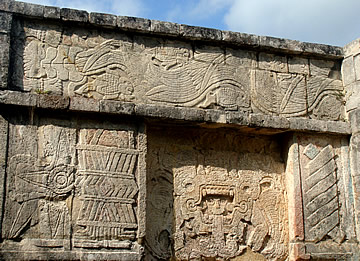
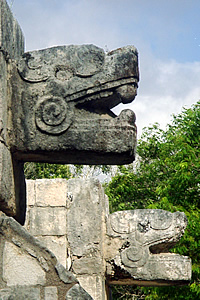
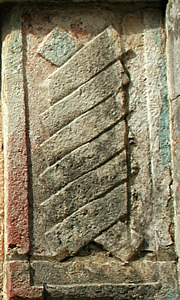
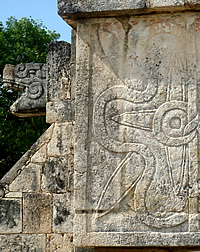
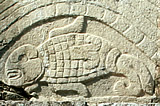
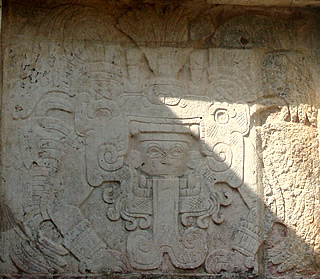
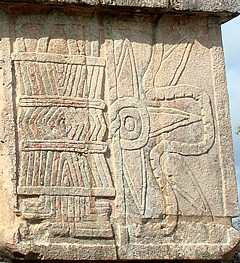
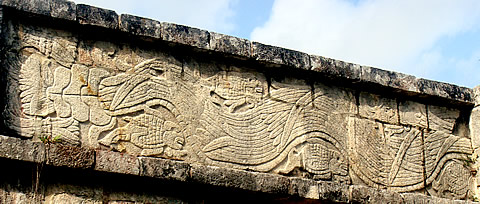
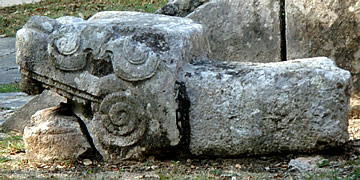
Originally all the buildings would have been painted in vibrant colours and vestiges remain here and there.
We continued north with our guide to the Sacred Cenote which is reached by a 300m long straight sacbé - an ancient Mayan road.
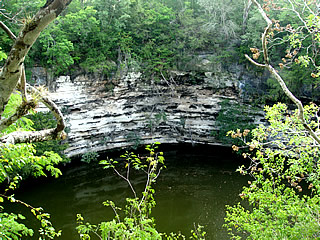
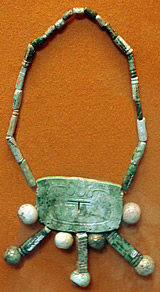
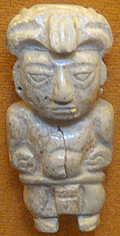
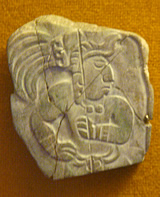
This is thought to be the most important of the chenotes at Chichen Itza, 60m in diameter and over 30m deep, with the water around 20m below the rim.
The rain god, Chaac, was believed to dwell here, and human sacrifices and valuable offerings, including many jade pieces, were thrown into the water.2 Some of the artefacts can be seen in the Merida Museum of Anthropology and History.
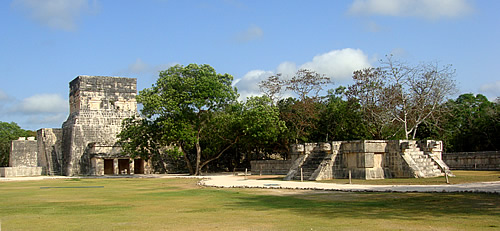
Returning to the grand plaza local traders were starting to set up stalls selling crafts and tourist merchandise ready for the arrival of the bus loads of tourists which come from the coast - not an appealing sight or prospect.
The Temple of the Warriors, Group of a Thousand Columns and the market area lie on the east side of the grand plaza. Though our guide gave us some information on these did not go into this area and planned to return after all the tourists had left later in the day - we were staying at the hotel at Chichen Itza.
We made our way west to the fabulous Platform of Eagles and Jaguars and the monumental buildings beyond.

Similar in shape and design to the Platform of Venus, here too there are pairs of feathered serpent heads at the top of the staircases.
The stone panels around the platform are decorated with carvings of jaguars, eagles, reclining figures, possibly warriors. Both jaguars and eagles grip dripping human hearts in their claws - could this have been a sacrificial platform?
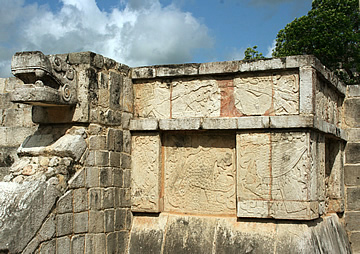
Sculptures of the plumed serpent appear all over Chichen Itza, a sign of Toltec influence. Once upon a time they would have had a plume sprouting from the top of the head but these are long gone.3
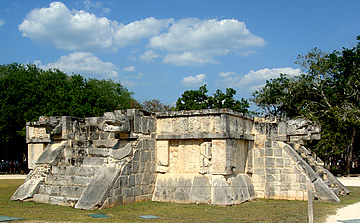

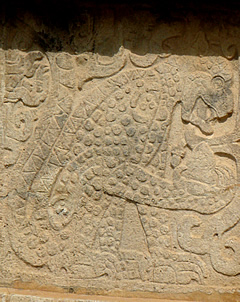
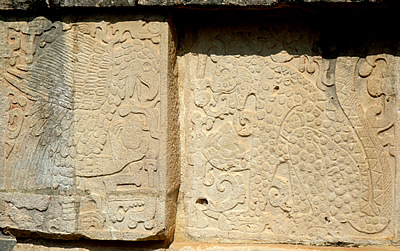
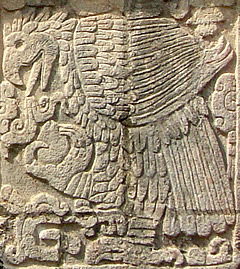
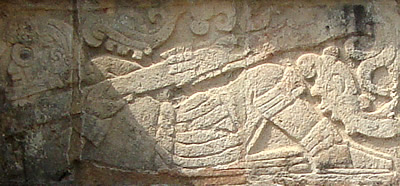

Behind is the Platform of the Skulls - a Tzompantli. It is a long, thin, platform with a central apron stage-like projection and steps on the east side.
The walls of the main long platform are completely covered with carvings of skulls. The walls of the "stage" have carvings of warriors and eagles in a sea of snakes.
It is thought that these platforms were used to display the severed heads of victims, either from sacrifices or possibly from ball games. They were displayed on vertical poles, pretty gruesome, but then England's warring rulers used to display heads of executed prisoners and rivals above city gates and on London's Tower Bridge in the distant past!
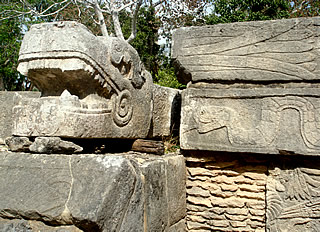
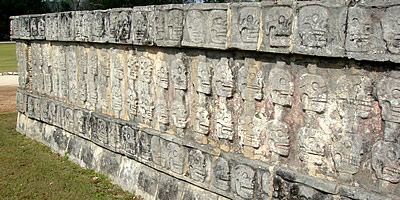
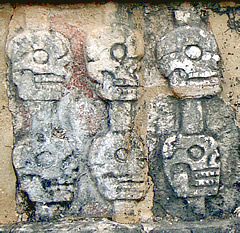
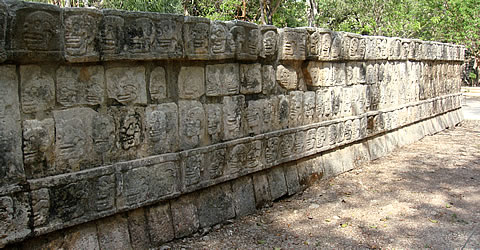
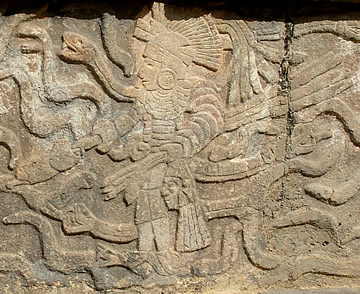
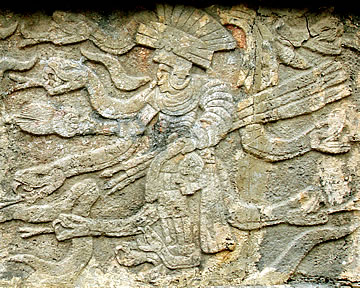
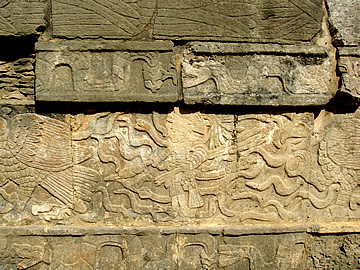

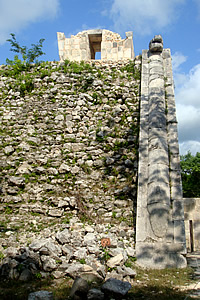
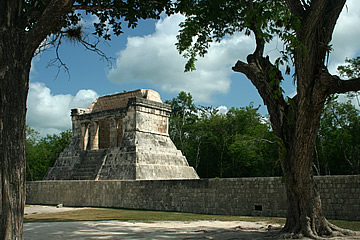
We walked around to enter the ball court at its northern end.
The ball court is the largest ever discovered - 166m x 68m.4 It has 8m high walls with the "playing" space between. Each of the parallel walls has a ring, about six metres from the ground. Because of the enormous dimensions it is believed by some that this was never a ball court where an actual game was played and was perhaps used for ceremonial purposes.
At the northern end the space is closed off by a small temple.
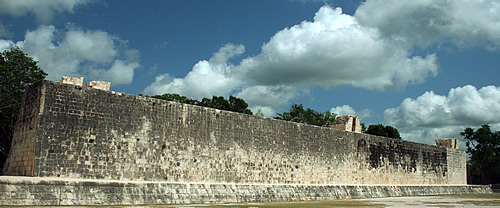
The west wall has three small structures on top and the east wall two similar structures at the north end and center with the Upper Temple of the Jaguar at the south end.
At the southern end are the remains of another building.
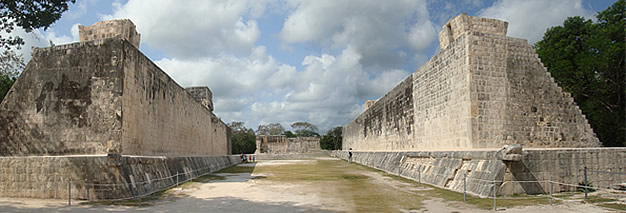
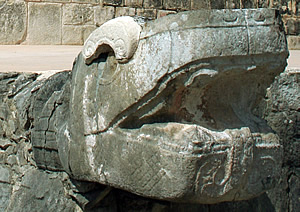
Each wall stands on a platform with serpent heads at the inner corners, the feathered bodies of the serpents stretching along the length of the platform.
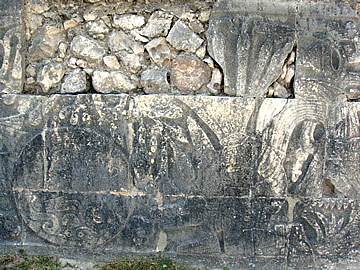
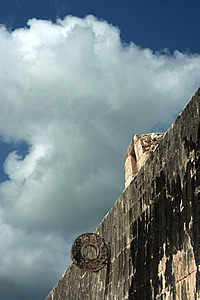
The platforms were decorated with carvings of warrior/ballplayers, including tableaux of a winner holding aloft the severed head of a loser who crouches on one knee, snakes leaping from his neck. Between them is a large ball decorated with a skull. Actually, it is unknown whether it is the winner or loser who has his head cut off - it may have been regarded as a great honour!
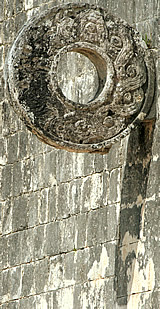
The rings are decorated with intertwined snakes, similar to patterns on the Temple of the Jaguar.
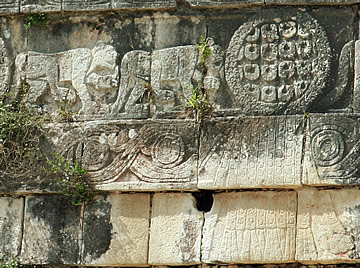
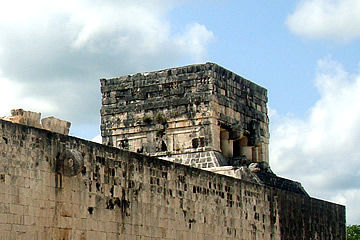
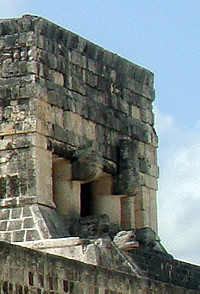
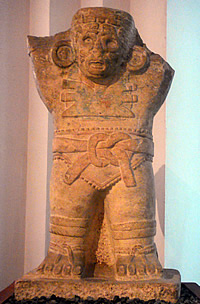
The Upper Temple of the Jaguar has two very impressive feathered serpent columns of a very unusual design: the heads rest on the ground and the bodies for columns which bend at right angles to support the lintel of the entrance. It is no longer possible to climb up to the temple.
Inside the Upper Temple was a large horizontal stone slab - a table or altar perhaps. It was supported by stone figures with upraised arms called Atlantes. At Chichen Itza they represent mythical creatures who separated heaven and earth.
The carving on the top frieze extends right around the building and includes a lovely string of stalking jaguars.
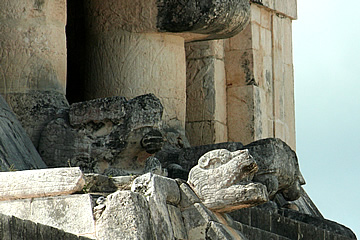
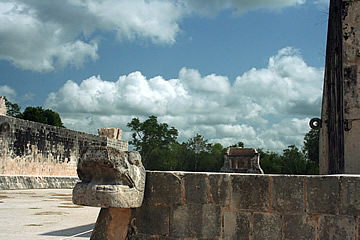
We went around the south end of this wall of the ball court to see the front of the Temple of the Jaguar. Here the Lower Temple of the Jaguar faces east toward the Platform of Eagles and Jaguars. It is a curious construction, this Temple, making the ball court walls asymmetric. It, and its particular location, must have been very important to the ruler of the time.
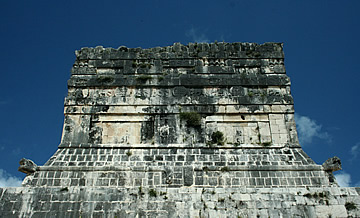
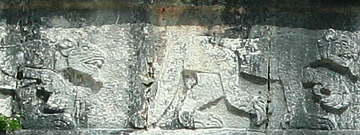
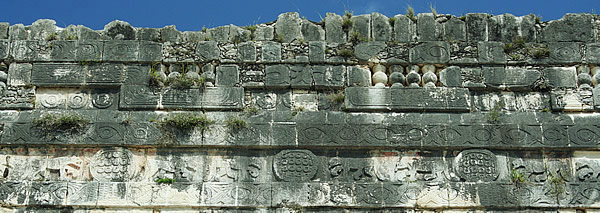
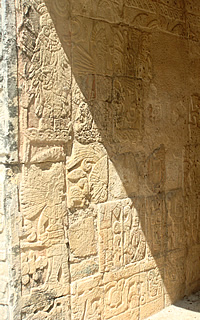
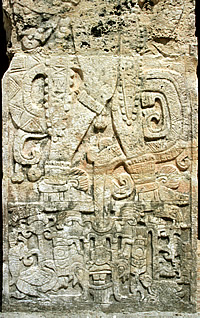
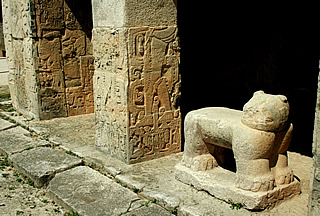
The Lower Temple has a jaguar throne which has lost all of its original decoration. and decorated square columns.
The interior walls are decorated with carvings of warriors carrying what look like short swords and bundles of spears and wearing feathered head-dresses and capes.
The columns have carvings of warriors and Kukulcan.
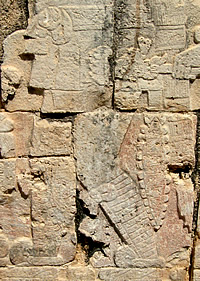
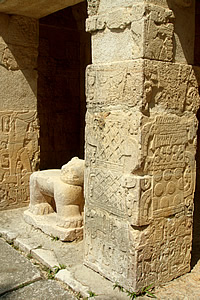


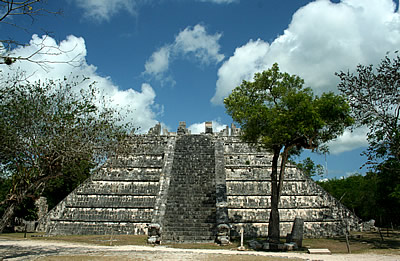
We made our way south from the ball court towards a four-sided pyramid known as the Osario or Ossuary or Tomb of the High Priest - a tomb was found within the pyramid.
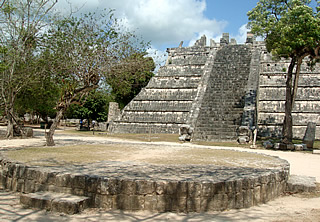
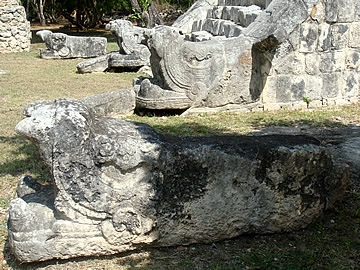
The pyramid has a staircase on each side flanked by sinuous serpent borders ending with the heads on the ground, and on the top more massive serpent heads in front of the ruined temple.
In front of the pyramid a low circular platform may have been used for ceremonial purposes.
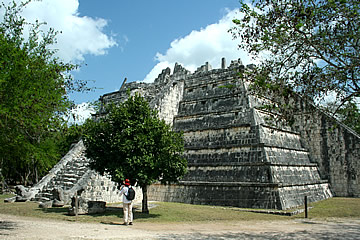
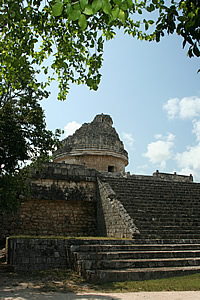
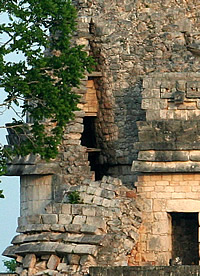
Further south we came to an area of buildings which has been identified as the earlier phase of construction at Chichen itza. The structure known as El Caracol or the Observatory is one of the more famous of these.
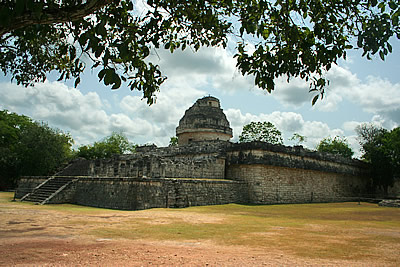
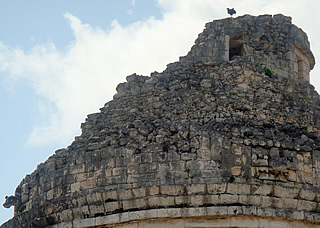
El Caracol is the Spanish word for snail - the internal structure is a spiral.
Circular structures began to be built in the Terminal Classic and Early Postclassic periods,2 often associated with the cult of Quetzalcoatl. There are serpents down the sides of the platform steps leading to the Observatory, however masks adorn its roof. The building was used to study the movements of the stars and planets through several windows. The study of celestial bodies is not out of line with a worship of the plumed serpent which can be associated with Venus.
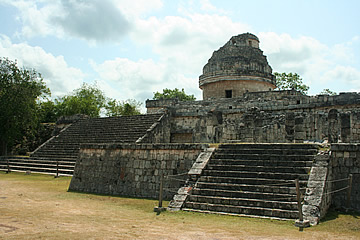
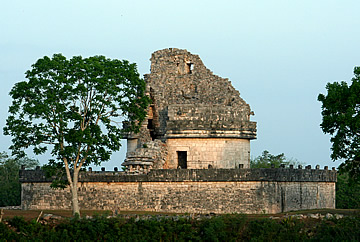
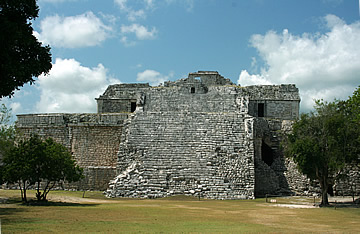
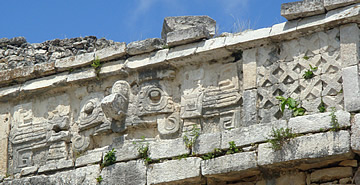
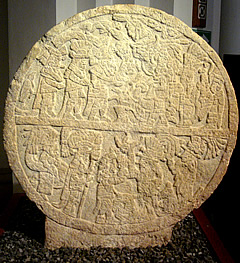
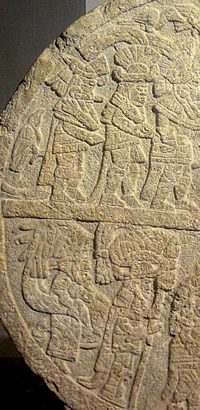
A stone disc found in El Caracol, and now on display in the museum at Merida, shows, according to the museum info, heaven in the top half because there are birds depicted, and the underworld below.
Two figures on the upper left hold their left arms across their chest, in an attitude of salute and obeisance, while holding out something in their right hand. There are birds above and to the side of them.
Along the curved edge are 24 glyphs, 8 of which refer to ahau - rulers and others of high rank.
It's an interesting piece and it would be nice to have a better idea of what it depicts.
Close by is the so-called Nunnery complex - the Spanish named this and its buildings with a purely partisan approach!
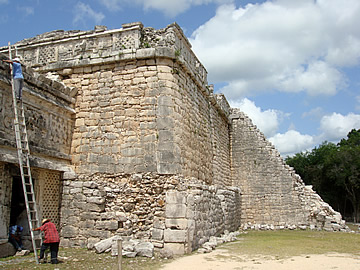
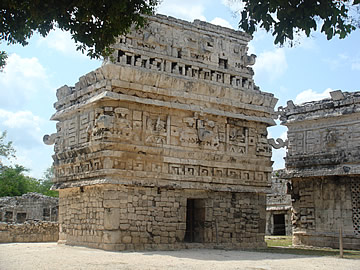
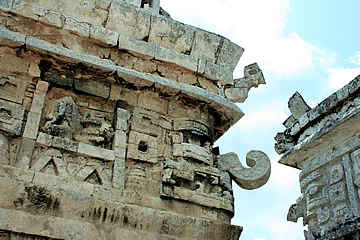
A huge platform with steep steps is topped by a large building. The east side of the platform still retains some very ornate carving, as does the building next to it facing west, dubbed "la Iglesia".
The carving here combines Puuc elements such as Chaac masks and finely carved veneer stone over a rough core, with other styles such as the serpent designs of Toltec.5
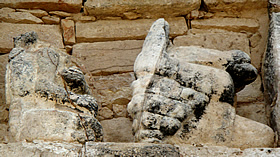
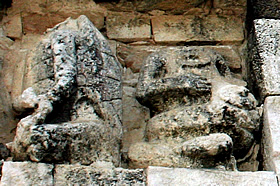
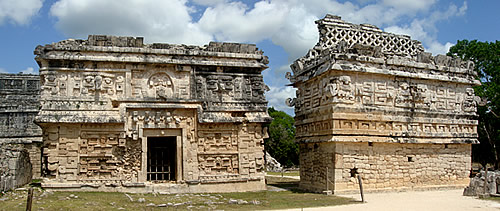
La Iglesia has Chaac masks on the four corners, the centre of the long sides and on the roof frieze, geometric and serpentine carvings, plus two pairs of curious figures either side of the west-facing central Chaac mask, rather damaged, which represent the four "bacabs" which hold up the sky in Mayan mythology: a crab, an armadillo, a turtle, and a snail - notably all four have strong body "armour"!6
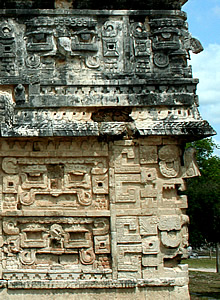
The east end of las Monjas is covered with mask of a long-nosed god, curly moustaches suggest Tlaloc rather than Chaac - though he doesn't have the goggle eyes seen at Uxmal, and various sinuous serpents. Above the entrance is a cross-legged figure with splendid feathered head-dress sitting under a canopy - he must represent someone very important. His arms are crossed in front and his hands grasp his shoulders. vestiges of colour - red, yellow, green - remain.
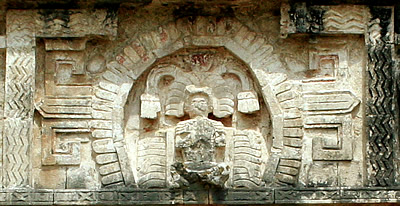

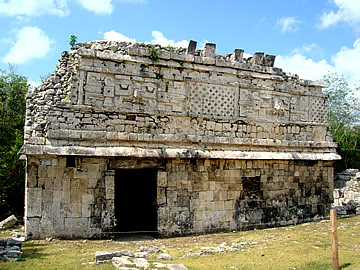
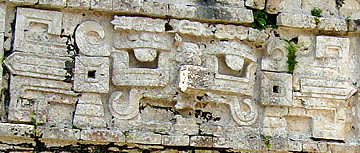
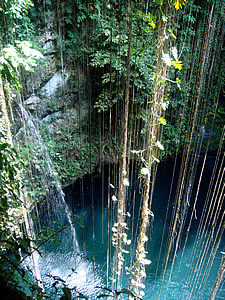
This was the end of our guided tour - it was about 11 a.m. and hordes of tour groups were arriving from Cancun! But our guide had one last surprise for us. He led us to Ik Kil, the most beautiful blue cenote.
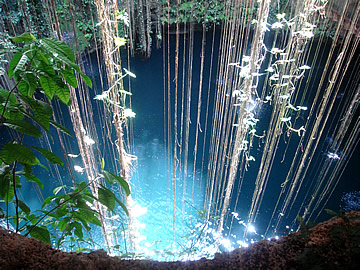
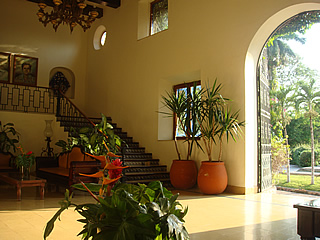
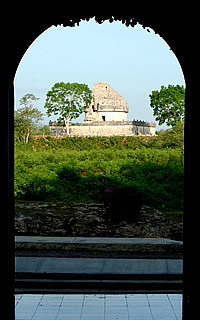
After a very acceptable lunch at Ik Kil we went to check in to our hotel, the Mayaland Resort Hotel, chosen principally because it has its own entrance to Chichen Itza. We were booked into one of their cabins but the first one they showed us had a leaky sink, the second the air con was all in pieces, the third was also not in great condition - rusty sink and air con, flies everywhere, and almost certainly mosquitoes.
Later we asked to be moved into the main building and were given a much nicer room with a huge balcony where we felt much more comfortable.
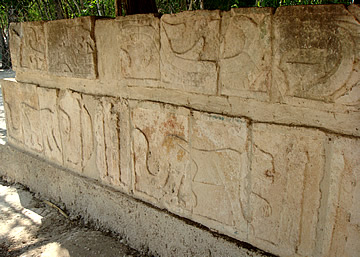
Later in the afternoon we ventured back into the site, mainly to visit the multi-columned area to the east of el Castillo.
On the north west corner of this area, facing into the Grand Plaza and El Castillo, is the Temple of the Large Tables celebrated Temple of the Warriors.
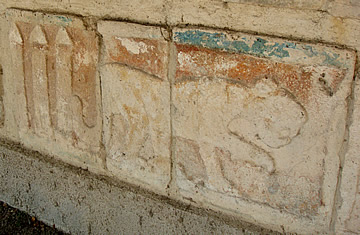
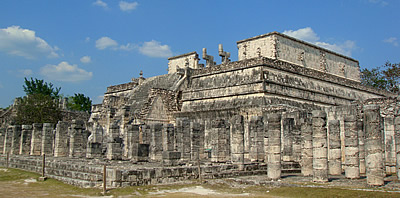
The Temple of the Large Tables sits on a stepped pyramid and had altars supported by small atlantes figures. The walls were decorated with beautiful jaguar carvings.
The Temple of the Warriors, adjacent to the south, is much grander and has the famous Chac Mool at the top of the steps. Behind the Chac Mool are two of the beautiful angled serpent columns.
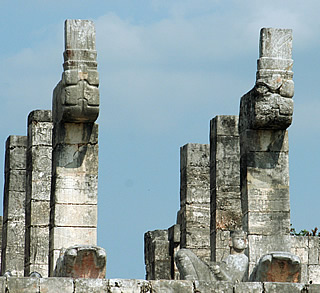
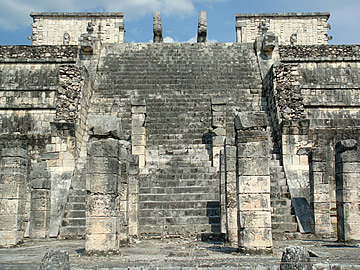
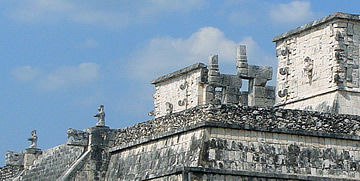
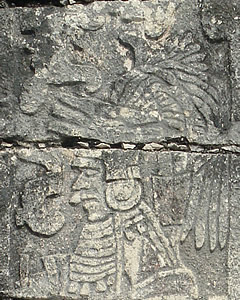
The square columns in front of the steps are covered with carvings of warriors wearing extravagant plumed head-dresses - it is from these carvings that the temple gets its name.
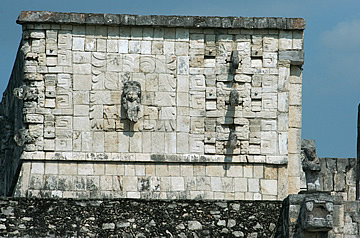
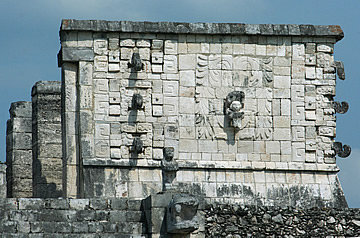
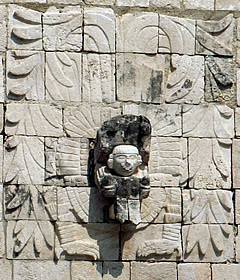
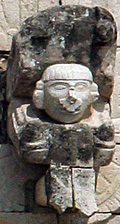
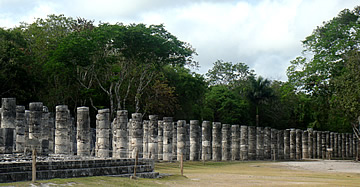
South and east of the Temple of the Warriors stretch immense arrays of columns forming the north and west sides of a vast space known as the Plaza of a Thousand Columns.. From here the south side of the temple can be seen.
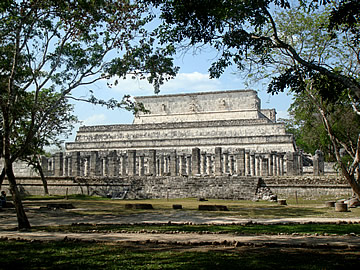
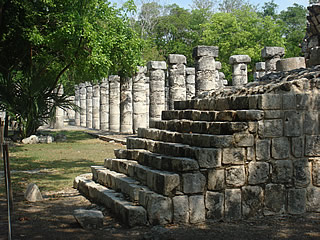
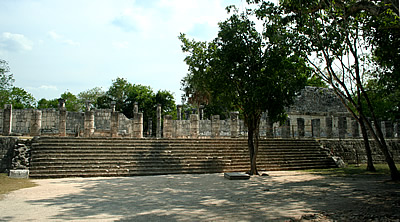
There were other buildings around the plaza, on the south side, to the east, is a long building with a cloister-like courtyard behind was once thought to resemble a market place and is now known as el Mercado - the Market, though it was probably more of a ceremonial space.
There were at least three more normal sized ballcourts here, almost certainly these were the ones used for the ritual ball games.
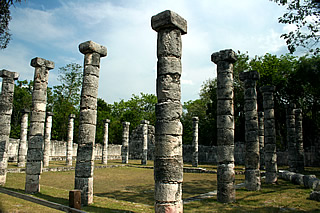
There are lots of colourful fruits and beautiful trees, especially in the hotel grounds which are watered.
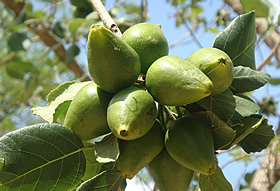
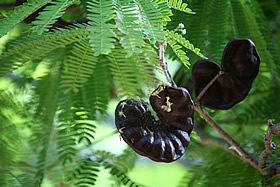
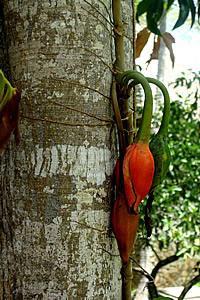
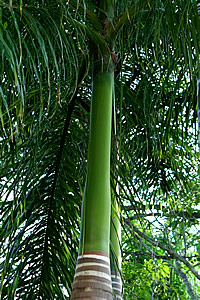
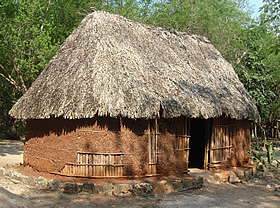
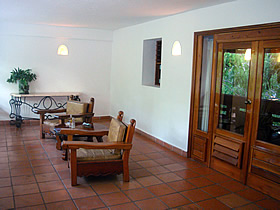
We returned to the hotel and cold beer on the balcony!
The hotel had an expert cocktail bartender and he also introduced us to chelada - iced beer in a glass, the rim of which is rubbed with lime and salt.
That evening we decided to skip the Sound & Light show and have a leisurely meal in the hotel restaurant - a beautifully presented sweet and sour chicken with very good cocktails beforehand too!
